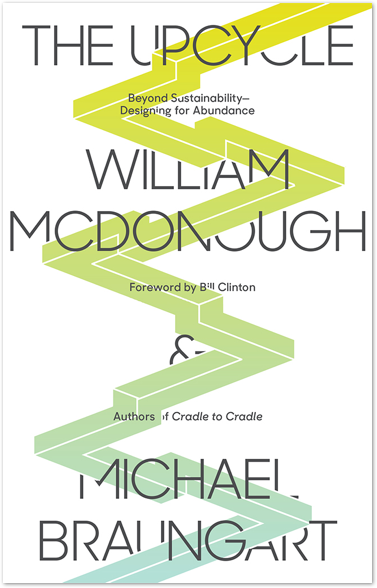
The Upcycle by William McDonough and Michael Braungart is the followup to Cradle to Cradle. Written in 2013, it brings a decade’s worth of new information and experience to the concept of Cradle to Cradle design thinking.
If you’re interested in the circular economy and can only read one book – this is it. There is a short section at the front that recaps the underlying principles of Cradle to Cradle systems in case you haven’t read the first book. While Cradle to Cradle was groundbreaking for the concept that we should design human industry to be a positive good for the environment, The Upcycle contains many more specific examples of projects where the authors were able to achieve these ends.
For example, in the book there is a story of Dan Juhl who pairs farmers with investors for building renewables on their land. The investors get a guaranteed return on their investment for ten years, and the energy generation equipment reverts to the farmers after this period. More renewables end up on the grid, and families get an additional source of income by owning the means of energy production.
The physical book itself is a nice counterpoint to the design of Cradle to Cradle. While Cradle to Cradle was designed to be reusable in technical nutrient cycles, The Upcycle is designed with biodegradable inks and paper so that it can become a biological nutrient again. One of the main ideas of Cradle to Cradle design is that things should be delineated into two separate nutrient streams: biological and technical. Wood, paper, and things of this nature can be reused as they would be in nature by returning to the land while technical materials like plastics and metals should be reclaimed for infinite technical cycles. Preventing the creation of “monstrous hybrids” is an important goal of the Cradle to Cradle design process. These materials are amalgamations of material that are difficult, if not impossible to separate and reuse. This is particularly harmful if the materials in these hybrids are toxic in nature. The book quotes McDonough, “Let’s put the filters in our heads and not at the end of pipes.”
The Upcycle is a breath of fresh air. McDonough and Braungart show how we can rethink the way we design everyday objects to fit into the constant cycles of Mother Nature and end the insanity of cradle-to-grave mentality. Cradle-to-Cradle design is definitely the way we should be thinking when we design technologies and objects for our solarpunk future.
Do you use any Cradle to Cradle products in your life? What has your experience been? Let us know below!
Pingback: Plastics – A Tidalpunk Antagonist | Solarpunk Station